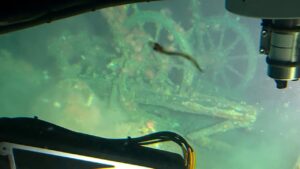Earlier this month, Eric Batty, Buck Miller, Ryan Atkins and Ted King cycled along the southern edge of James Bay, an extension of Hudson Bay sandwiched between Ontario and Quebec, in midwinter. They covered the 600km in eight days on what they dubbed the James Bay Descent.
They started at Attawapiskat and tried to pedal across James Bay to Akamiski Island in the territory of Nunavut. Although they managed to edge into Nunavut, a lead of open water stopped them from reaching the island itself. Thereafter, rather than cycle untracked sea ice, they opted to travel the ice road that operates for six weeks in midwinter. South of Moosonee, they joined a second ice road that ran south to their finish point at Smooth Rock Falls.

Their projected route.
During the expedition, ExplorersWeb spoke with Buck Miller, who clearly couldn’t get enough of the ride.
Why take on such an expedition?
I know the area very well, because I spent five years living in Moosonee, on the James Bay coast. I used to bike around the small community and found the ice roads great riding, smooth and fast. I always wanted to give the James Bay Winter Road, which runs north to Attawapiskat, a try. But living in such a remote town, one doesn’t have technical gear shops, bike shops or any other stores that would provide the means to take on such a trip. Fast forward to 2015, and I reconnected with Eric, and old racing friend. Together, we crossed [Ontario’s] Algonquin Park in 2018 with Ryan Atkins. It was on that trip that we decided to give the James Bay Descent a crack.

The scrubby subarctic forest in that part of northern Ontario allowed them to use a woodstove and old-fashioned tent.
What is route like?
This route has never been attempted on fat bikes, and no one had ridden fat bikes from Ontario to Nunavut, and back to Ontario before. James Bay is very remote, yet it’s often overlooked by adventurers in winter. It’s brutally cold, inhabited by polar bears, caribou and arctic foxes. In short, northeastern Ontario is rugged, desolate and gorgeous, and we want to showcase that, all for a good cause. The route leads from Attawapiskat to Akamiski Island in the territory of Nunavut, and back down the frozen sea ice of James Bay, following near the shoreline roughly 300km to Moosonee and Moose Factory. From there we take the Wetum Winter Road south to a remote hydro station, Otter Rapids, and a forest access road further south to the small town of Smooth Rock Falls, where I was born.

One of the fat bikes, in better weather. Photo: Eric Batty
For non-cyclists, can you describe a fat bike?
Fat bikes are mountain bikes on steroids. The frames can accommodate tires up to 5″ wide that provide lots of flotation for multi-surface riding. They work best on sand and snow. With low tire pressure, there are very few places a fat bike can’t go.
What equipment have you been carrying?
We’re packing very light because we have only about 80 litres of storage on our bikes. We have a teepee-style tent, an ultralight titanium woodstove, camera gear and enough food for 12 days. We’ll have one change of clothes each, a down jacket and many merino and synthetic layers.

Along the ice road.
What are the risks?
Risks include exposure to extreme temperatures, in the -35°C to -50°C range, very high winds and polar bears along the coast of James Bay. We’ll be carrying a 12-gauge shotgun with slugs, as well as bear bangers for defence. [In the end, they encountered no bears.]
How about food?
At home, most of us eat like regular working people, and even knock back the odd pint of beer. We all stay healthy and balance food and exercise with our daily routines of work and, in the case of Eric and I, being fathers. But on the bikes, we can’t carry enough calories with us, although we’ve brought the highest calorie dehydrated meals we can find: oatmeal every morning with some trail mix, maple syrup waffles for lunch, chocolate…

Tough slogging.
How did you plan?
I’ve studied the route very well, measured it countless times. In mid-January, the four of us met in the Adirondacks for a weekend of testing gear and sleeping at the top of Whiteface Mountain after a five-hour training ride. We found the trip to be hugely successful.
What’s next?
Eric will make a film that documents our expedition, and we raised $5,000 to donate to the Timmins Native Friendship Centre. They do great work for the indigenous community of Moosonee/Moose Factory. We’ll also start planning another expedition for 2020, but those details are still too young to air.






